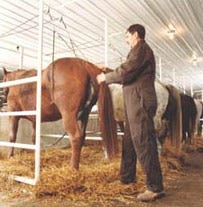The Endochronology of Estrogen: Part I: A Yo-Yo Trip Through the Ages
From Cow Ovaries to Horse Urine
Hi Beautiful Friends,
In the long process of drafting this post, many times I’ve said to myself, “you just can’t make this sh%$ up.” From cow ovaries to horse urine, Big Pharma to Big Natural, oral “synthetic” to transdermal “bioidentical,” throughout the years hormone therapy has been both touted as the miracle elixir and condemned as a devastating carcinogen derived from abused animals.
Join me on an exciting journey in three parts. Let’s start from the beginning.
Imagine going to the doctor and being treated to an ice cold douche! How about having your vagina plugged, or your pelvis bound by a restrictive bandage to keep that wandering womb in place. Better yet, how about some leeches on the cervix or labia? If all else fails, maybe removal of the clitoris will do the trick! (Pain and Prejudice, p. 87, 100)
Before the discovery of hormones and modern medicine, female symptoms were often treated with misguided, ineffective, and even dangerous measures. So we’re making progress!
Organotherapy
In 1887, a German doctor gave an extract from cow ovaries to a 52-year old woman suffering from hot flashes. By 1899, Ovarin, made from powdered cow ovary became commonly available. (Menopause Manifesto, p. 213-214)
Estrogen Discovered and Isolated
In 1906, the term "estrogen” derived from Greek “oistros” (mad desire) and “gennan” (to produce) became the term for secretions from the ovaries of female animals.
In 1923, scientist Edward Doisy became head of the biochemistry department at St. Louis University Medical School where he began analyzing the urine and follicular fluid of pigs. By 1929, both a German team and Doisy’s team had isolated and purified estrone, a type of estrogen from human urine.
At about the same time, the first estrogen patch was manufactured by the drugmaker Searle.
Emmenin (not to be confused with Slim Shady)
In the early 1930s, Canadian biochemist James Bertram Collip (instrumental in the development of insulin), extracted and isolated estrogen from human placenta. The compound was named Emmenin* and was used commercially for the effective treatment of painful periods.
*Tangent! This 1935 article from the Canadian Medical Association Journal is both informative and amusing. The scientific explanation for dysmenorrhea (pain during menstruation) was illuminating. The description of the “psychopathic constitution,” the author’s explanation for why a patient didn’t find relief from Emminem, is an elaborate work of art. I can’t help but include this Shakespearean passage:
“The features most striking to the observer in the character of such sufferers are the heterogeneous medley of moods and whims, of sympathies and antipathies; of ideas in turn joyous, stern, gloomy, depressed and philosophical; of aspirations at first charged with energy, then dying away to nothing. These patients are usually the most naïve of egotists. They talk exclusively and persistently and absorbedly of themselves and their ailments, and consequently efforts to impress them with the importance of a course of treatment are of no avail on account of their heedlessness.”
I’m torn because while the author appears oblivious to the subjectivity of his account, he’s also describing some of my family members, not all of them female, to a tee. The problem is that throughout history, as is illustrated in this article, women’s pain has more than not been ascribed to “psychogenic” causes or arising in the mind, especially when medical practice cannot explain the cause. While this document drips with patronizing sexism in places, still, kudos to this team in believing the majority of women complaining of menstrual pain and studying it to develop a treatment. Blaming those who did not find relief in the medicine is an ongoing problematic aspect of traditional medical prejudice that I am exploring in a post on the trust gap coming soon.
Problems with Premarin
In 1941, the Canadian drug company Ayerst, McKenna & Harrison, which later became Wyeth and then Pfizer (the current manufacturer), brought to market a drug extracted from pregnant horse urine-“Premarin.” Depending on who you ask Premarin has somewhere between 10 and 50 different estrogen compounds. In fact, it’s Premarin’s complex combination of estrogens (called conjugated equine estrogens or CEEs), and its high bioavailability that ultimately prevented other drug companies from being able to develop generic versions, which allowed Wyeth to monopolize the market on hormone therapy from the 1940s until 2002.
In 1943, Premarin was FDA approved for safety and was mass produced for hot flashes nearly two decades before the approval of the first birth control pill in 1960.
Estrogen and Uterine Cancer
In 1947, Saul Gusberg, a Columbia University gynecologist linked estrogen to cancer of the lining of the uterus.
In 1975, the New England Journal of Medicine published an article linking unopposed estrogen to uterine cancer, bringing this risk to light three years after the FDA approval of Premarin for efficacy and thirty-two years after approval for safety. (The Hormone Decision, p. 60-61)*
It’s baffling that studies on hormone therapy would only come after many years of real life experimentation. Barbara Seaman, a woman’s health advocate wrote a book The Greatest Experiment Ever Performed on Women referring to hormone therapy, including birth control, which was more her focus. Her criticism of prescriptions without data was legitimate. Luckily, we have much more data now than we ever have before, and it’s there for those of us willing to go out and find it.
The link between estrogen and uterine cancer hurt Premarin sales and spurred women’s groups to demand more evidence. Studies revealed that “the risk of uterine cancer among hormone users could be reduced to a rate below that of non-hormone users if progestin was added to their treatment.” (The Hormone Decision, p. 71) With this problem solved, it again became business as usual for Premarin.
Bone and Heart Health
Further boosting Wyeth’s sales, a 1982 report stated that estrogen helped combat bone loss. In 1984, a statement from the National Institutes of Health Consensus Conference on Osteoporosis stated that estrogens were the most effective treatment for bone loss prevention, a statement that remains true today. This announcement upgraded Premarin from a short-term solution for menopausal symptoms to a long term solution for a chronic, life-threatening disease that impacts a large population of women.
Between 1985 and 1998 there were multiple studies (Framingham, Nurses’ Health, PEPI, HERS) showing conflicting results. By the late 1990s, there was enough evidence drawing a connection not only between hormone therapy and bone health but also improved cardiovascular health, that prescription of hormone therapy for all women of a certain age became common practice. In fact, what we know now is that estrogen (especially oral) reduces LDL (the cholesterol responsible for build up of plaque in the arteries), is anti-inflammatory, and helps protect the endothelial lining of blood vessels.
By 1990 Premarin had made $1.5 billion.
Premarin and Prempro (introduced in 1990, a combination of Premarin plus medroxyprogesterone acetate) were the drugs tested in the WHI study, the study meant to end all studies on hormone therapy and find conclusive evidence once and for all. If you’ve read any of my other posts you know it didn’t exactly end up that way. Or you can read this post:
The Darker Side of Premarin (Trigger Warning: Animal Cruelty)
When I was a kid my father had a horse farm and I took riding lessons. I’ve always had a soft spot for horses. When I heard on a podcast from a well-known doctor (who has written what some refer to as “The Menopause Bible”) that the horses used for urine extraction suffered abuse and neglect, I was shocked. In addition to the animal cruelty, this doctor was saying things about hormones and biology that I hadn’t heard before. There is a reason for that. More on this interesting doctor in Part II where she comes to play a bigger role in the journey of hormone therapy.
Initially, I wrote off the animal abuse story because I believed the source was unreliable, and probably also because I didn’t want to believe it. If this horse abuse were real, surely we would have heard about it by now, right? This news would definitely have come out in the wake of the WHI when Premarin was vilified and deemed unsafe for human consumption.
I found the following post by Dr. Jen Gunter, who I have come to trust as a savvy and knowledgable arbiter of hormone truth. In the post, she calls the concerns about the collection of Premarin, some of which have been covered by NBC, and by ScienceDirect, a “propagation of myths.”
I wanted to take her word for it, but her references (mostly industry or industry-hired) were ones that I couldn’t imagine came without their own biases. So I kept digging. I’m afraid that at the height of Premarin sales it was not a good time to be one of the 40,000 Premarin (PMU) farm horses, and that’s an understatement.
On PMU farms, horses are kept in tie stalls for 5-6 months at a time, and are mandated to be taken outside only once every two weeks. Yes, it’s butt cold outside in the winter in Manitoba, Canada, the predominant location of PMU farms, an excuse you might hear along with the assurance that the barns are “temperature controlled.” It’s hard to imagine that the horses wouldn’t prefer some exposure to cold to what they face indoors.
The stalls are big enough for them to take a few steps forward and back, and technically big enough for them to turn around, but they can’t because they are tied up and hooked up to a collection piece under their vulvas. Even in the best lighting and angles on the NAERIC (North American Equine Ranching Information Council) website, the pictures of the barns reveal the unnatural and cramped living situation the pregnant mares endure year after year.
Here’s another image:
Lying down rarely happens due to limited space. Lying flat out, as pregnant mares often do for relief from the heavy load, is impossible. Some have reported the horses aren’t given a continuous water supply as to increase the concentration of estrogen in their urine. The NAERIC website itself says “Ranchers’ contracts are in grams of estrogen, not unit volume of urine.” This statement doesn’t in and of itself prove that ranchers withhold water, but the incentive is certainly there.
It seems like the blessing in disguise of the WHI was that demand for Premarin dropped precipitously (80% reduction in hormone therapy prescriptions followed the WHI) and so too did the need for pregnant horses.
Pfizer has more recently added another drug Duavee, that also requires conjugated equine estrogen. Equine Advocates claims that after the WHI, Wyeth/Pfizer:
“…began moving production abroad where local regulations are more lax, and there are significantly fewer FDA inspectors available to monitor production. Reportedly, this not only results in significantly more horrific conditions for the mares but also less oversight in the manufacturing of an already dangerous drug. There are reportedly 90,000 mares currently on PMU lines in China.”
Pfizer’s drug fact sheet for Duavee describes it as containing CE, dropping “equine” from the term “conjugated estrogens” and obscuring that the drug requires extraction from pregnant horses.
One last unfortunate fact about the PMU industry is the by-product- a baby horse. The American Veterinary Medical Association in a 2002 statement meant to dispel accusations, concedes: “….yes, foals are sold at auction by the hundreds to feedlot operators, who then send them to slaughter for European and Asian meat markets.” This statement is listed as a reference on Dr. Gunter’s post where she argues that the animals are treated humanely. While she does state that Premarin isn’t vegan, I think we might disagree on the care animals deserve. She might be more sympatico with Dr. Allan Preston, director of the Veterinary Services Branch for Manitoba Agriculture and Food, who stated: “From my perspective as a person who has worked with the industry in various capacities now for almost 30 years, this is a very acceptable role for the horse to play in society.” The agricultural industry and the ranchers who own PMU farms seem to have a perspective not shared by animal welfare groups. Norm Luba, the executive director of NAERIC refers to the human consumption of horsemeat as “a cultural issue; it’s an emotional issue.” That aside, taking foals from their mothers at unnaturally young ages, a regular practice on PMU farms, is beyond the problem of cultural relativity. It’s a universal and moral issue. The separation of mare and foal causes great emotional distress to the animals.
After listening to a 2015 presentation by Vicki Burns (President of the Board of The Canadian Federation of Humane Societies from 2011-2013), I’m convinced that the stories are not a “propagation of myths,” but are grounded. In 1994, Burns was the Executive Director of the Winnipeg Humane Society when she began investigating. Winnipeg is about a 2.5 hour drive from Brandon, Manitoba, the primary location of the PMU farms so she drove out to take a look. The conditions described above are what she details in the presentation below. What she has seen with her own eyes I have not, yet I can’t seem to find a motive for her to fabricate.
From the Horse Ethologist’s Mouth
The post below dissects Dr. Gunter’s piece better than I have and includes research on horse behaviour, such as forced separation, provided by someone who specializes in ethics on horses.
I’m Not Vegan
I’m not a vegan but I did become one temporarily after reading Animal Liberation by Peter Singer. I challenge you to read that book and not turn vegan. If you’re already not sleeping due to hormonal fluctuations, I don’t recommend this book. After becoming anemic, I began eating meat again. I’m sure if I prioritized it, I could figure out a vegan diet that didn’t deplete my iron supply, but then my family might disown me. For the time being, we try to buy meat from farms that follow animal welfare standards.
I understand the treatment of PMU horses isn’t worse than what happens in the hog or cattle industries, or to humans for that matter. Cruelty happens.
As long as we know how our choices impact other living beings, we can at least make informed choices, not ignorant ones.
Not Your Mother’s Hormone Therapy
While Premarin remains the most commonly used hormone therapy in the US, “bioidentical” transdermal estradiol is becoming more popular and is the top-selling hormone therapy in Europe and some other countries. In fact, following the release of a British documentary on hormone therapy, the UK, the Netherlands, and Greece recently experienced panic-inducing shortages of transdermal estradiol due to a surge in sales.
We have the most evidence for Premarin since it’s been around for so long and used so widely. In one of the settled lawsuits against Wyeth after the WHI, the council for the drug company used the argument that 99.62% of hormone users in the WHI “did not get breast cancer.” In fact, some, like Dr. Avrum Bluming (Estrogen Matters) say there could be some added benefits to CEEs over transdermal estradiol. Just as we don’t lump all medications in one class together, we should know the different efficacy and mechanistic profiles of the different forms of estrogen available to us. I’ll address these differences in Part III.
Stay Tuned for Part II (a): Premarin’s Marketing Campaign of Feminine Forever
In Solidarity











Eye-opening! I had no idea about the treatment of the pregnant horses for collecting their urine. Thank you for doing a bit more digging and sharing your findings. Looking forward to Part 2!
“Emmenin (not to be confused with Slim Shady)”. Nicely done. lol. Thank you for your research. I had no idea. Not fun to read about the treatment of pregnant horses, but I’m glad to be more informed.